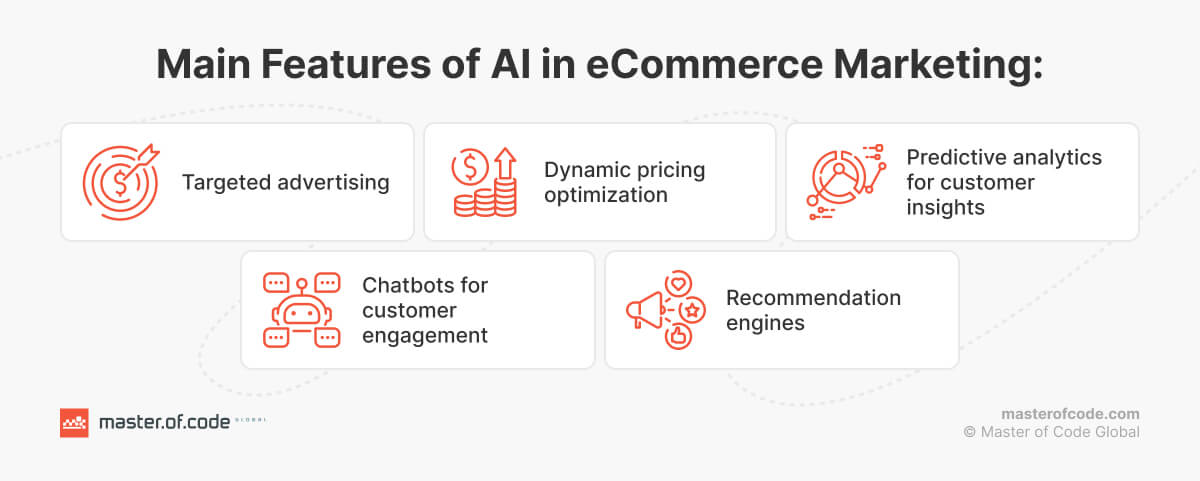Discover the secrets to building chatbots that convert visitors into loyal customers.

Artificial intelligence is disrupting how online stores operate, interact with customers, reduce returns, and optimize the entire shopping experience. Using AI is no longer optional for eCommerce businesses – it’s essential for survival and success.
From personalized product recommendations to AI-powered chatbots, the technology is streamlining operations, boosting efficiency, and driving buyer engagement in numerous ways. More than 60% of retail survey participants intend to increase their investment in AI infrastructure over the coming 18 months.
This article will dive into the exciting world of Conversational AI in eCommerce. Why should you read it till the end? You’ll get a full overview and understanding of the following:
- The Core Benefits: Learn how artificial intelligence addresses major retail challenges, enhancing efficiency, personalizing experiences, and increasing client satisfaction.
- Real-World Statistics: Get insights into the current state of tech adoption in this industry and its impact on key business metrics.
- Practical Use Cases: Discover how companies use machine learning (ML) algorithms for product recommendations, intelligent and visual search, customer support, fraud detection, and much more.
- Illustrative Examples: Consider cases of firms successfully applying AI to transform their eCommerce operations and achieve tangible results.
Whether you’re just starting to explore AI or looking to maximize its potential, this article will provide a full guide to understanding how machine intelligence is shaping the future of online commerce. Let’s start!
Table of Contents
AI in eCommerce: Main Statistics and Facts
Partly due to its portrayal in popular media and partly due to the buzz around it, artificial intelligence has almost always been in the spotlight. It is reported that the technology is helping to increase retailer’s revenues by up to 15%. This also means that there is a vast pool of studies and reports documenting its growth. Yet there are a lot of misconceptions regarding all things related to AI.
We’ve compiled this data under two main areas of performance to get a quantitative understanding of how AI is being incorporated into digital commerce companies and provide the numbers businesses can use to make better-informed decisions in 2026.

AI Adoption in eCommerce Statistics
In 2026, eCommerce is one of the leading adopters of artificial intelligence, followed by FinTech and Online Media (platforms such as YouTube). Artificial intelligence in eCommerce has increased tremendously in the past 5 years and it’s only going to increase in the coming years as according to a recent study, 84% of eCommerce businesses are either actively working AI solutions into their business or have it as a top priority.
The following statistics give us a better insight into the adoption of Conversational AI in eCommerce businesses:
- More than half of the companies we surveyed (54%) have implemented GenAI in some areas of their business (PwC)
- The impact of Generative AI on the global eCommerce sector, valued at $5.920 trillion, is expected to be extensive. That is why companies are trying to evaluate new technologies and test their ability to level up their chatbots to Generative AI Chatbot with new, wider functionality.
- The use of voice recognition is important as 22% of users prefer talking to an AI voice assistant instead of typing. (Pew Research)
- Another 26% of respondents state that AI voice assistants give them an easier way to use other features. (Pew Research)
- In another report, 75% of IT leaders stated that usage of AI technology will help enhance security. (Statista)
- 23% of companies interviewed have already implemented AI chatbots and another 31% of companies plan to deploy AI chatbots in 2024. (Salesforce)
- The global Conversational AI market size is expected to grow to $13.9 billion by 2025. (Business Wire)
- Facebook Messenger hosts over 300,000 active chatbots. Chatbots are also one of the most popular methods of implementing AI in eCommerce. (Hootsuite)
The increasing rate of adoption is driven by many factors such as the new customer demand, cost-effective and personalized customer service, and the need for more accurate insights into Conversational AI trends. However, on a more fundamental level, AI adoption in the eCommerce industry is driven by its compatibility.

Real Benefits for the Industry
In 2026, online stores are one of the leading adopters of AI, followed by FinTech and Online Media (platforms such as YouTube). Artificial intelligence in eCommerce has increased tremendously in the past 5 years and doesn’t seem to stop in the coming years.
The following facts give us a better insight into the usage of Conversational AI in eCommerce enterprises:
- Generative AI is anticipated to have a significant impact on the sector, prompting companies to explore its potential by upgrading their chatbots.
- Voice recognition technology is gaining importance, with a notable percentage of users preferring voice assistants over typing and finding them helpful for accessing other features.
- Integration of AI tools has been reported to enhance employee productivity and contentment.
Additionally, the technology is predicted to play an important role in enhancing security. The implementation of bots is on the rise, with a large portion of organizations having already chosen them or planning to do so in the near future. The Conversational AI market is projected to experience substantial growth in the future. 20.1% of retail purchases are prognosed to take place online in 2024. As businesses evaluate emerging technologies, various advanced eCommerce solutions for small businesses are becoming an essential focus, enabling these enterprises to streamline operations and meet evolving customer expectations.
Chatbots are recognized as a popular means of implementing ML in eCommerce, with platforms like Facebook Messenger hosting many active digital assistants, such as TARS, Sequel, Botpress, etc. Finally, a big increase in AI handling customer service interactions is predicted, indicating a growing reliance on artificial intelligence in this aspect of business operations.
The increasing popularity of AI in eCommerce is fueled by many factors such as new customer demand, cost-effective and personalized solutions, and the need for more accurate insights into client trends. However, on a more fundamental level, AI adoption in the eCommerce industry is driven by its compatibility.
Such a business model is ripe for the use of artificial intelligence. Its adoption can make online stores far more efficient at moving products than brick-and-mortar shops. For instance, one of the advantages of AI in eCommerce is the potential to track the entire consumer journey including items shoppers are interested in. On the other hand, physical shops are limited to only tracking what the buyer checks out.
Statistics on AI Contribution to Sales
Over the years, online sales have been steadily growing, becoming a significant part of revenue. Ultimately, the impact on overall business profitability is the main factor when deciding whether to adopt artificial intelligence solutions. Specifically, Conversational AI development has shown positive results across various industries, including online retail. For instance, in the most recent State of AI report published by McKinsey, 79% of respondents stated that integrating AI into marketing and sales has increased business revenue. The increase in revenue varies but enterprises were able to generate at least 20% additional revenue thanks to AI-based business strategies. An example of AI being used for more effective marketing is the Luxury Escapes AI chatbot which increased the company’s response rate on retargeting efforts by 89%.
There are numerous ways eCommerce enterprises can use AI to improve sales figures. For instance, integrating it into business messaging and switching from traditional communication channels such as email can increase click-through-rates by 13 times.
Additionally, companies are investing in artificial intelligence to upgrade logistics, last-mile delivery optimization, and offers, but not only for Conversational commerce. For instance, Amazon uses its AI-powered recommendations engine to make personalized suggestions that drive 35% of the company’s annual sales. At the same time, big data analytics (also amplified by intelligent algorithms) has increased Amazon’s profits by an annual average of 143% by optimizing prices as often as every 10 minutes on the basis of multiple external factors like average online price, product availability, and demand history.
However, total sales aren’t the only factor affecting the bottom line. By using AI to reduce the cost of operations, eCommerce companies are increasing profit margins and thus operating more efficiently. Alibaba, one of the biggest online retail platforms, for example, has been investing in its smart logistics program and has managed to lower delivery errors by 40% to hundreds of millions. Another great example of AI-driven cost-savings is Netflix which saved $1 billion in lost revenue through a personalized recommendations engine that leveraged machine learning to improve its accuracy over time.
Types of AI Technologies in eCommerce
Approximately 28% of top-tier online retail companies have already implemented AI and machine learning. However, the numbers only provide a brief overview of what is a complex area of business with various implementations that are driven by different objectives. In other words, to fully understand the state of artificial intelligence, we need to look at the actual use cases.
Based on numerous studies and reports, we’ve compiled a list of the top 5 most promising practical scenarios in 2026.

Big Data Analytics & ML
Businesses have access to mind-boggling levels of data consisting of important metrics that can be used to create more effective sales, marketing, and production plans and make more data-driven decisions in general.
Although big data analytics is a growing industry on its own, it still uses artificial intelligence (and machine learning) to produce the results that it does. eCommerce enterprises are using big data analytics alongside data visualization and company intelligence (BI) tools to automatically monitor sales, demand, marketing strategies, inventory, supply chain components, and more in real-time.
ML covers various AI technologies, including supervised, unsupervised, and increase learning. Supervised learning trains models on labeled data for classification or regression tasks. Unsupervised learning discovers patterns in unlabeled data. Supplementing learning uses rewards to teach agents to make sequential decisions, which is crucial in gaming and robotics.
Furthermore, businesses are using AI along with big data analytics to regularly scan their website to flag fake reviews as well as scouring the internet for trigger phrases in social media posts, blogs, and even tweets (consumers often post about their experience or request support on such platforms instead of choosing the dedicated channels).
Lead Engagement and Retargeting
A lot of the data that eCommerce enterprises collect belongs to potential customers or leads. Artificial intelligence can be used to both reach out to cold prospects (who may not be aware of the brand) and warm leads (who have shown interest in the brand or product). In addition to this, AI is also known to be a very effective tool for retargeting customers.
Retargeting is a form of marketing aimed at customers who are in the sales funnel but haven’t pulled the trigger on the purchase. There are numerous ways the retargeting is done but most include personalized messaging. And the most customized form of business messaging available today is Conversational AI.
Conversational AI Chatbots & NLP
Virtual agents use advanced language processing and understanding technologies, marking a new type of digital interaction. These chatbots are capable of lifelike conversations by:
- identifying the context of the dialogue
- determining customer intention
- and even using a large knowledge base to form new answers.
More importantly, all of this can be achieved at very affordable costs and it’s part of the reason why chatbots have taken the market by storm. eCommerce businesses are deploying bots on popular messaging platforms such as Facebook Messenger, WhatsApp, and Kik to:
- improve engagement
- provide extra services and digital assistance
- offer 24/7 support
- create Points of Sale (PoS) on additional platforms, giving customers the ability to make purchases through their favorite messaging apps.
There is also Natural Language Processing (NLP). It involves AI technologies for understanding and generating human language. It covers tasks like sentiment analysis, named entity recognition, and machine translation. NLP also includes techniques such as word embeddings, neural language models, and transformer architectures, advancing communication between humans and machines.
Contextual Search and AI Recommendations Engine
Context-based searching is a strong function that can be added to websites and mobile apps to improve the precision of search results. It uses an AI engine that scans external data such as day of the week, season, trending topics, and more to make search results more accurate. Contextual search can also make related suggestions and auto-fill search phrases that are more likely to lead to a purchase.
Similarly, an AI recommendations engine is, in many ways, an extension to the contextual search engine and uses external data including browser history, cookie data that may include previous searches, purchase history, etc. to make personalized recommendations of products most relevant to the individual buyer.
Voice and Visual Search
We’ve briefly mentioned voice and visual search before and their growing importance which has increased its adoption across the eCommerce industry. Handsfree and even screen-free searches are becoming increasingly popular and implementing these smart voice assistants (Alexa and Google Home, for instance) into your website or mobile app will very likely help.
Computer Vision
Visual perception technology, a part of AI that helps computers interpret and understand visual information, is quickly changing how eCommerce works. Here’s how it’s making an impact:
- Visual Search Revolution: Shoppers can now search for products by uploading images or taking photos. This method eliminates the need to describe items with words, streamlining product discovery and improving search accuracy, especially for fashion and home decor.
- Personalized Recommendations: Computer vision analyzes buyers’ browsing patterns and image preferences to suggest visually similar products. This leads to highly tailored recommendations, increasing the likelihood of conversions.
- Fraud Prevention: It can spot counterfeits by identifying subtle inconsistencies in product images. It safeguards both businesses and consumers from fraudulent activities.
- Virtual Try-On: Technologies using computer vision enable customers to “try on” clothes, makeup, or accessories using augmented reality. This reduces returns and increases purchase confidence, especially for high-consideration products.
Computer vision is still a developing field, but its capabilities are rapidly advancing. Enterprises that integrate these visual AI solutions gain a competitive edge by offering a more intuitive, personalized, and engaging shopping experience.
AI Use Cases of Revolutionizing eCommerce: Main Examples
63% of consumers say that AI-powered product recommendations are highly influential on their purchases. Artificial Intelligence is rapidly reshaping the online shopping landscape, offering companies transformative solutions to address common challenges and enhance the customer journey. From personalized offers to efficient inventory management, AI is optimizing operations and driving growth across the entire eCommerce experience. Let’s dive into specific use cases and real-world examples of how machine intelligence is revolutionizing this dynamic sector.
Customers want answers to their customer inquiries in less than 10 minutes (often instantly). For instance, conversational AI-powered chatbots are capable of answering thousands of customer queries on their own, reducing resolution time from the average 38 hours to a lightning 5.4 minutes. Furthermore, not only are AI chatbots more powerful and always available, but they also cost far less than human 24/7 customer service agents, reducing costs by 30%.

Personalization
Hyper-Targeted Product Recommendations: AI algorithms analyze customer browsing history, purchase patterns, demographic data, and even real-time behavior to provide tailored product suggestions. These offers are far more relevant than generic ones, increasing the likelihood of conversions. The North Face uses IBM Watson’s AI to power its Expert Personal Shopper (XPS) software. Customers can interact with the AI to receive personalized jacket recommendations based on their responses to questions about their intended activities and preferences.
Personalized Search Results: AI-powered search engines go beyond simple keyword matching. They understand the context and intent behind a shopper’s queries, delivering more relevant results. Microsoft’s Bing search engine utilizes AI to provide personalized search results by considering the user’s location, previous search behavior, and interests. This enhances the relevance and accuracy of the search results.
Dynamic Website Content: Artificial intelligence can personalize the entire website experience based on individual profiles. This includes showcasing different product categories, promotions, and content tailored to each visitor’s preferences. 49% of consumers want to shop more often and spend time with retailers that are better at personalization.
Good Recommendations
Intelligent Image Recognition: AI-driven visual search is a convenient tool enabling shoppers to discover products through images, bypassing the need for text-based searches. This feature enhances shopping, particularly in industries like fashion and home decor.
By applying the technology, businesses can enhance engagement and satisfaction, leading to increased sales and loyalty. As AI continues to grow, its integration into visual search promises even more seamless and personalized experiences. This innovation not only benefits consumers by making product discovery more intuitive but also empowers enterprises to better cater to the preferences and needs of their target audience in visually-driven industries.
For example, Pinterest offers a robust visual search tool, allowing people to easily find similar items by uploading or highlighting desired products within images. This functionality simplifies the search process and appeals to users who prefer visual browsing.
Customer Service Upgrade With Gen AI
24/7 AI Chatbots: Conversational bots offer instant assistance, address common queries, and facilitate transactions around the clock, enhancing customer enjoyment by reducing wait times. They’re widely adopted on eCommerce platforms to handle FAQs, gather lead data, and assist customers during checkout. These chatbots streamline shopping, ensuring seamless interactions and boosting conversions. With their ability to swiftly respond to inquiries and provide personalized help, these systems play a crucial role in enhancing client engagement and loyalty. Bank of America employs AI chatbots to help people with banking transactions, account inquiries, and other financial services.
Personalized Support Journeys: AI technology can analyze interactions and provide tailored solutions, or product recommendations preemptively. This approach greatly enhances troubleshooting, as customers receive relevant assistance without needing to initiate inquiries. By understanding individual preferences and needs, systems streamline the support process, minimizing frustration and increasing satisfaction. This proactive aid not only resolves issues more efficiently but also strengthens the bond between clients and brands. Netflix utilizes personalized algorithms to recommend content based on user’s viewing history and preferences, creating a tailored entertainment experience.
Improved Logistics & Inventory Management
Demand Forecasting: AI algorithms analyze historical sales data, market trends, and external factors like weather to predict future demand more accurately. This empowers businesses to optimize inventory levels, minimizing stockouts and avoiding overstocking. By attaching predictive analytics, companies can anticipate fluctuations in consumer demand and adjust their supply chain accordingly, ensuring efficient operations and maximizing profitability.
This proactive approach to inventory management enables enterprises to meet expectations consistently while lowering carrying costs and reducing waste. Walmart is one of the pioneers in using demand forecasting to manage inventory levels, optimize supply chain logistics, and anticipate client demand across its vast network of stores.
Warehouse Automation: Robots and systems modernize warehouse operations by handling tasks like selecting orders, packaging, and optimizing shipping routes. This automation enhances efficiency, lowers operational costs, and minimizes errors, leading to smoother logistics processes. By using artificial intelligence, warehouses can achieve higher throughput rates, meet increasing demands, and adapt to dynamic market conditions more effectively.
Additionally, AI-driven systems enable real-time monitoring and analysis, allowing for proactive problem-solving and continuous optimization of workflows. FedEx integrates warehouse technologies such as automated sorting tools, robotics, and conveyors in its distribution centers to enhance package sorting and delivery operations.
Fraud Detection
Anomaly Detection: AI utilizes advanced algorithms to analyze extensive transaction data, identifying patterns and behaviors indicative of fraudulent activity. This enables machine intelligence to detect anomalies that traditional rule-based systems might overlook, thereby safeguarding both companies and customers from potential fraud. By continuously learning from new data, AI tools can adapt to evolving fraud tactics and provide more effective protection over time.
It not only reduces financial losses but also preserves trust and reputation within the business ecosystem. PayPal adopts anomaly detection algorithms to monitor transactions and discover suspicious activities such as fraudulent payments or account takeovers.

Accurate Forecasting
Sales Forecasting: In addition to managing inventory, AI can predict overall sales trends by checking various factors. It assists firms in financial planning, devising marketing strategies, and allocating resources effectively. By using predictive analytics, companies gain insights into market demand fluctuations, seasonal trends, and consumer behavior patterns. This enables them to make data-driven decisions that optimize sales performance and maximize profitability.
The Coca-Cola Company implements sophisticated forecasting models to forecast beverage demand across different markets and seasons, ensuring optimal production and distribution of its products.
Cross-Selling and Upselling
AI-Powered Bundling: Using AI, businesses analyze buying behavior to suggest complementary products or curate personalized bundles, ultimately driving up the average order value (AOV). By understanding individual preferences and shopping habits, artificial intelligence can tailor recommendations, leading to more effective upselling and cross-selling strategies.
This not only enhances the shopping experience for customers but also boosts revenue for companies. Spotify uses recommendation systems to present personalized music playlists and bundles to its users. These selections often include songs and artists similar to those the user has listened to or liked in the past. AI-driven personalization helps Spotify effectively upsells premium features such as ad-free listening and high-quality audio.
Targeted Upsell Offers: AI examines shopping carts and individual profiles to recommend relevant upgrades or premium versions of products at checkout. This personalized approach enhances shopping by providing tailored suggestions based on past behavior, increasing the likelihood of upselling and boosting revenue for companies.
Uber implements targeted upsell offers within its app by suggesting upgrades to premium ride options, such as UberXL or UberBlack, or offering discounts on future rides for users who upgrade to a higher-tier membership program.
The widespread adoption of AI in eCommerce is proof of its tangible benefits. As these technologies continue to develop, we can expect even more innovative and transformative applications in the years to come.
Benefits of Artificial Intelligence in eCommerce
One of the main reasons behind the reluctance to integrate AI solutions was the cost involved. Even though the technology itself is half a century old, most of the advancements and proliferation that made it economically viable for small-to-medium enterprises (SMEs) happened in the last 5-10 years. As a result, the advantages of artificial intelligence adoption are now more accessible than ever.
Integrating artificial intelligence into your business model has two kinds of benefits. The first kind includes the functionality added by machine intelligence itself. For instance, by integrating AI-powered voice search, customers will have an easier time navigating your website and potentially increasing revenue. We’ve already mentioned quite a few benefits of additional functionality in the previous two sections but there is a broader positive influence of the technology on businesses. Let’s take a look at these company-wide benefits of AI in eCommerce.
Reduced Operating Expenditure
One of the many advantages of artificial intelligence is that it makes automation much more available and flexible. As a result, enterprises can automate more tasks and reduce operating costs. Most of the popular AI implementations today already do this by replacing a capital-intensive and inefficient business process, for instance, call center automation.
Additionally, even the implementations that aren’t directly designed to cut expenses, can do so by simply being more economical to operate than their traditional counterpart. One of the most common examples of this is the usage of artificial intelligence to process consumer data for marketing. Using non-AI tools or employees for such tasks would take longer, be more expensive, and potentially have more errors.
Reduced Personnel Costs and Dependence on Human Capital
Communicating well with consumers is critical in any B2C industry but online shopping has different challenges compared to offline buying. For instance, shopping assistance is still required but it’s not nearly as useful to online buyers as it is to offline ones. This means that many companies have high personnel costs but with relatively low ROI. At the same time, dependence on humans means they cannot reduce staff.
This is where consumer-facing AI solutions are tremendously advantageous. They offer a viable alternative to the human workforce while reducing the fixed costs associated with them. One of the most common examples of this is the use of conversational chatbots to reliably provide 24/7 support, which is less expensive than human agents.
Increased Productivity
The benefits of AI automation extend beyond 24/7 customer service and into daily operations within the company. Once again, automation plays a central role in reducing the burden by taking over numerous business tasks including document management, communication, fraud detection and prevention, etc. This helps save valuable work hours and enables employees to work more efficiently.
An increase in productivity will be even more apparent in legacy companies where the majority of the tools and technologies are outdated.

Wrapping Up
AI is an undeniable force reshaping the eCommerce landscape. Its ability to analyze vast amounts of data, reduce returns, automate tasks, and provide personalized experiences offers significant advantages for businesses of all sizes. The examples and statistics presented illustrate the tangible impact the technology can have on client satisfaction, conversion rates, and ultimately, profitability.
However, it’s important to remember that AI isn’t a magic bullet. Successful adoption requires a strategic approach that prioritizes ethical data usage, seamless integration with existing systems, and continuous monitoring of the outputs.
By embracing AI as a strategic partner, companies can remain competitive in an increasingly crowded market. The future of eCommerce is undoubtedly tied to innovation. Those who start investing in AI development solutions today will be well-positioned to reap the rewards of more efficient and customer-centric online shopping.
If you’d like to learn more about how your eCommerce business can prepare itself for Conversational AI future and artificial intelligence, consult an expert today.
Ready to build your own Conversational AI solution? Let’s chat!






